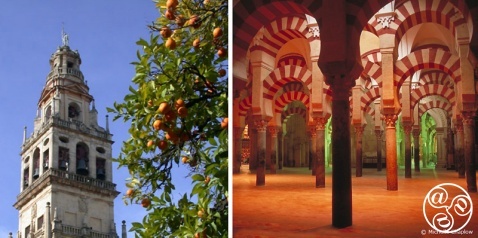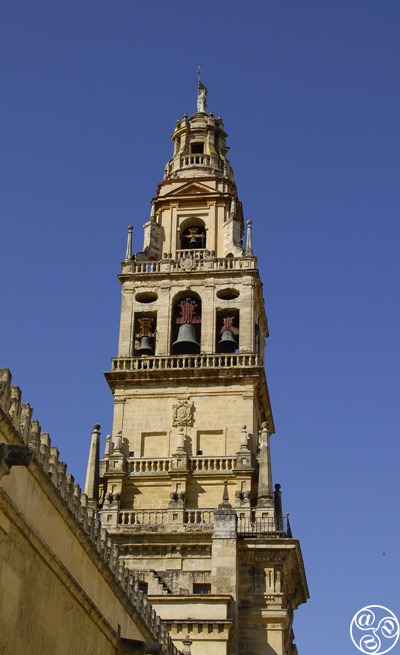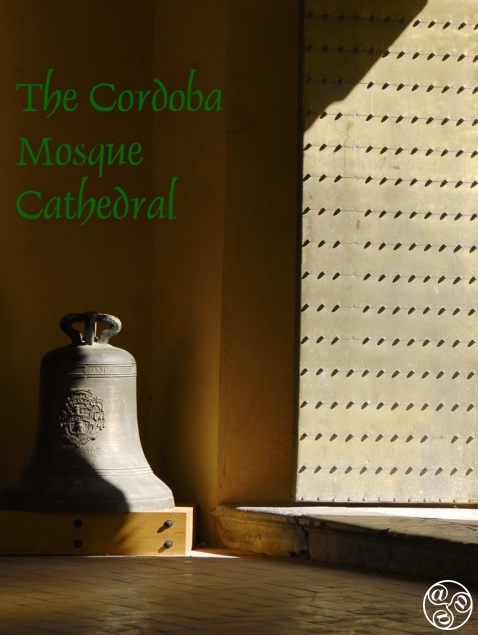
Cordoba's Mezquita is a Blend of Moorish and Christian Architecture. © Michelle Chaplow |
|
The Mosque Cathedral
The Mezquita (Mosque) dates back to the 10th century when Córdoba reached its zenith under a new emir, Abd ar-Rahman III who was one of the great rulers of Islamic history. At this time Córdoba was the largest, most prosperous cities of Europe, outshining Byzantium and Baghdad in science, culture and the arts. The development of the Great Mosque paralleled these new heights of splendour.
Today the Mezquita de Cordoba (Cordoba Mosque) as it is comonly known (or the Cordoba Cathedral as it was know by its owners the Catholic church) can be visited throughout the year for an entrance fee. Following a dispute between the church and the city over the name of the building in the 2010's it is now diplomatically called "Cordoba Mosque Cathedral".
The approach is via the Patio de los Naranjos, a classic Islamic ablutions courtyard which preserves both its orange trees and fountains. When the mosque was used for Moslem prayer, all nineteen naves were open to this courtyard allowing the rows of interior columns to appear like an extension of the tree with brilliant shafts of sunlight filtering through.
The Arches
A first glimpse is immensely exciting. Jan Morris described it as "so near the desert in its tentlike forest of supporting pillars." The architect introduced another, horseshoe-shaped arch above the lower pillars. A second and purely aesthetic innovation was to alternate brick and stone in the arches, creating the red and white striped pattern which gives a unity and distinctive character to the whole design. There are more than 850 coloured granite jasper and marble pillars in total. Sunlight streams in from windows in the four cupolas creating interesting effects combined with artificial light from the thousands of small oil lights.
The Mihrab
This traditionally had two functions in Islamic worship, first it indicated the direction of Mecca (therefore prayer) and it also amplified the words of the Imam, the prayer leader. At Cordóba it is particularly magnificent. The shell-shaped ceiling is carved from a single block of marble and the chambers on either side are decorated with exquisite Byzantine mosaics of gold. The worn flagstones indicate where pilgrims crouched on their knees. The Cordoba Mosque Mihrab looks south in the same way as the Damascus mosque and not south east in the direction of Mecca.
The Cathedral
In the centre of the mosque squats a Renaissance cathedral which dates back to the early sixteenth century while, to the left is the Capilla de Villaviciosa built by Moorish craftsmen in 1371.
The Mosque was consecrated as a Christian Cathedral in the same year that Cordoba was re-conquered (1236). Alfonso X built the Villaviciosa Chapel with stunning multi lobed arches. The Capilla Real (Royal Chapel) was also built as a pantheon for Christian Kings.
In the 14th century Enrique II rebuilt the royal chapel in Mudejar style. In 1523 with the support of King Carlos V the church built a huge nave inside the mosque. The cathedral was elaborated on over the years by many of the country´s leading architects and artists. Architect Hernán Ruiz continued working transforming the Cathedral into Gothic style.
The main retable in red marble is a neo-classical work of art by Álonso Matias with five painting by Antonio Palomino and sculptures by Pedro de Paz. The Baroque tabernacle is by Sebastian Vidal.
The two mahogany pulpits by Verdiquier are interesting because they feature a near life size bull and a lion in veined marble and an eagle in black marble. The baroque mahogany choir stalls were carved by Duque Correjo in the 18th century.

The Bell Tower
The Torre de Alminar is 93m high and was built on the site of the original minaret. Its posible to climb the steps to the very top for superb views of Cordoba.
The Entrance Gates
There three main decorated gates dating back to Moorish construction. On the east the enlargement by Almanzar featured poorer reproductions of earlier gates. La Paloma door was reformed in gothic style in the 15th century.
Patio de Los Naranjos
There is no charge for the entrance to the Patio de Los Naranjos which is a large outer courtyard where you can rest from the Cordoba sun before entering inside the other sections of the mosque. The entrance tickets are sold from a kiosk here.
Guided tours in Mosque / Cathedral of Córdoba city
Book guided tours in Mosque / Cathedral of Córdoba city
Private Guided tours in Mosque / Cathedral of Córdoba city
Book private guided tours in Mosque / Cathedral of Córdoba city
Visiting Information
Entrance fee:
Adult €10.00
Children €5.00
Children under 10 Free
Mon to Sat, 8:30 a.m. to 9:30 a.m. Free but individually and in strict silence.
March to October
From 10.00 a.m. to 7.00 p.m. from Monday to Saturday
From 8:30 a.m. to 11.30 p.m. and 3.00 p.m. to 7.00 p.m. Sundays and holidays.
November - February
From 10.00 a.m. to 6.00 p.m. from Monday to Saturday
From 8:30 a.m. to 11:30 p.m. and 3.00 p.m. to 6.00 p.m. Sundays and feast days
There are opportunities to buy tickets online as part of guided tours but entrance tickets can only be purchased from the ticket kiosk in Plaza de los Naranjos at Mosque-Cathedral. Queues are not generally an issue like the Alhambra in Granada. If you are concerned about queuing, it is also possible to buy earlier in the day for later collection.
















